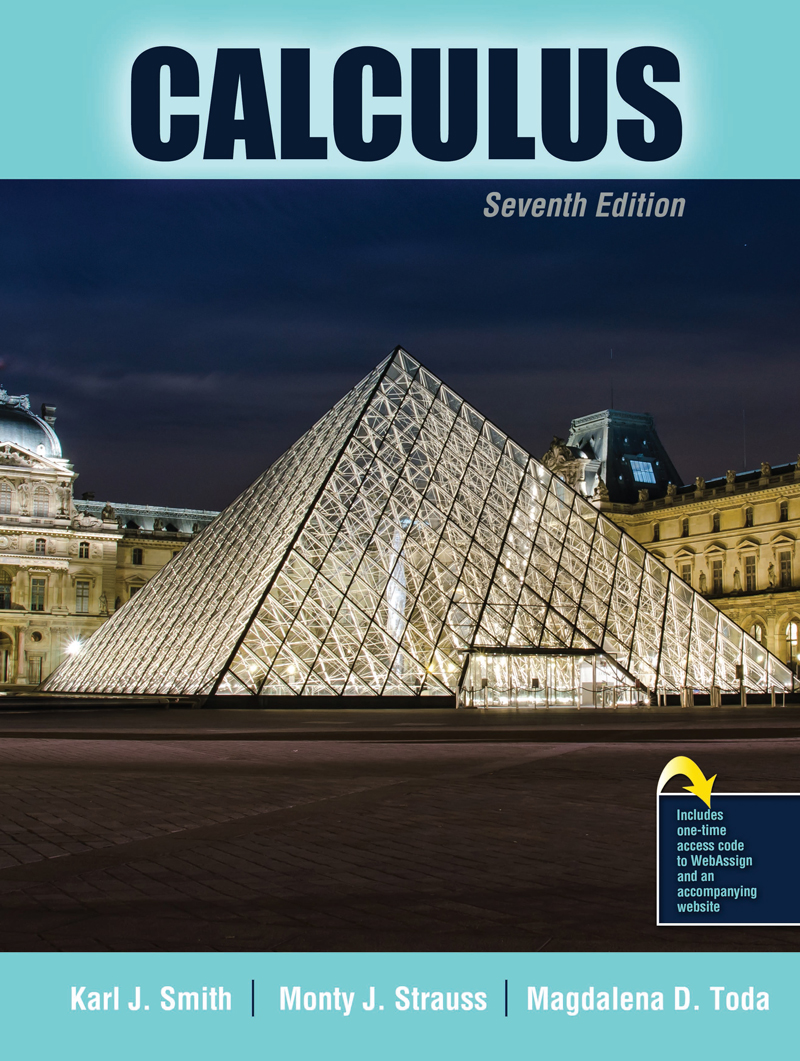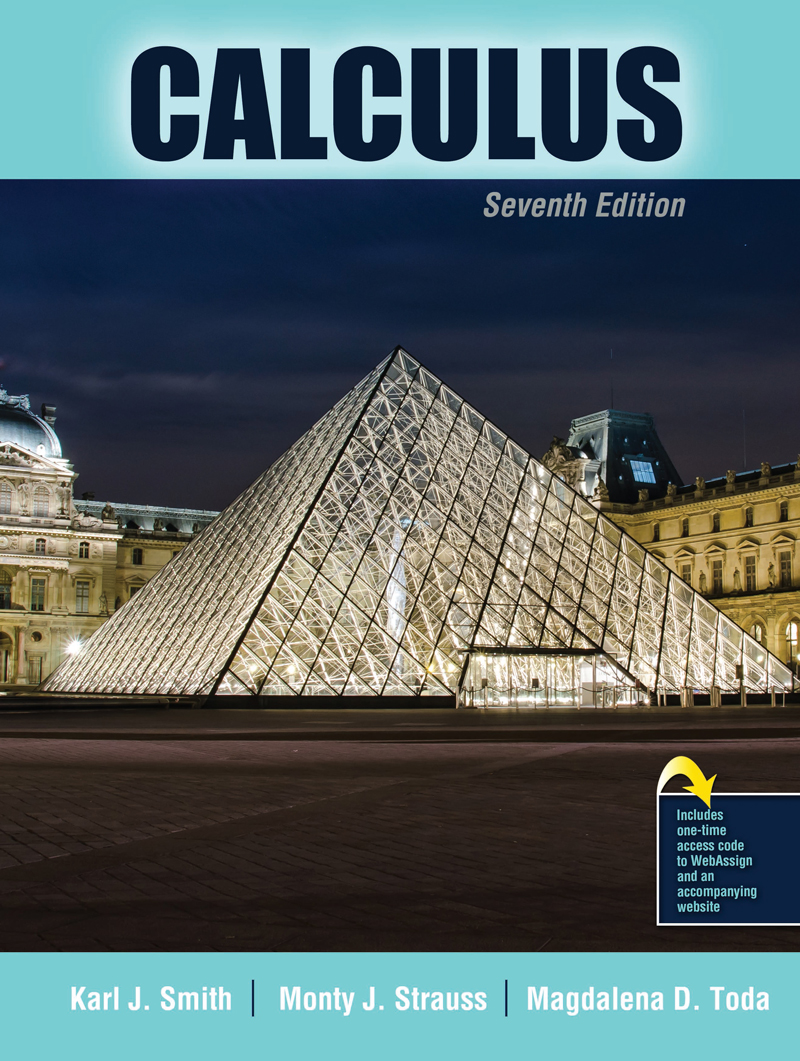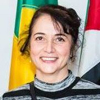Calculus
Author(s): Karl J Smith , Monty Strauss , Magdalena Toda
Edition: 7
Copyright: 2017
Edition: 7
Copyright: 2017
Pages: 1292
Choose Your Format
Choose Your Platform | Help Me Choose
Calculus blends the best aspects of calculus reform along with the goals and methodology of traditional calculus. The format of this text is enhanced, but is not dominated by new technology. Its innovative presentation includes:
- Conceptual Understanding through Verbalization
- Mathematical Communication
- Cooperative Learning Group Research Projects
- Integration of Technology
- Greater Text Visualization
- Supplementary Materials
The new seventh edition of Calculus:
- Is an early transcendental book, but does include an optional section that defines the logarithm as an integral.
- Incorporates over 7,300 problems! Most of these are available on WebAssign© which provides instant assessment.
- Has been updated! The new edition features drawing lessons that include hints on plotting points in three dimensions, drawing circles, ellipses, hyperbolas, trigonometric curves, and polar-form curves, as well as planes and lines in three dimensions.
- Interactive art -Many pieces of art in the book link online to dynamic art to illustrate such topics as limits, slopes, areas, and direction fields
- An early presentation of transcendental functions: Logarithms, exponential functions, and trigonometric functions
- Differential equations in a natural and reasonable way
- Utilization of the humanness of mathematics
- Precalculus mathematics being taught at most colleges and universities correctly reflected
- Think Tank problems to prove the proposition true or to find a counterexample to disprove the proposition
- Exploration Problems that go beyond the category of counterexample problem to provide opportunities for innovative thinking
- Journal Problems have been reprinted from leading mathematics journals in an effort to show that “mathematicians work problems too”
- Modeling Problems requires the reader to make assumptions about the real world in order to come up with the necessary formula or information to answer the question
- A student solutions manual, instructor’s manual, and accompanying website
1 Functions and Graphs
1.1 What Is Calculus?
1.2 Preliminaries
1.3 Lines in the Plane; Parametric Equations
1.4 Functions and Graphs
1.5 Inverse Functions; Inverse Trigonometric Functions
Chapter 1 Review
Book Report Ethnomathematics by Marcia Ascher
Chapter 1 Group Research Project
2 Limits and Continuity
2.1 The Limit of a Function
2.2 Algebraic Computation of Limits
2.3 Continuity
2.4 Exponential and Logarithmic Functions
Chapter 2 Review
Chapter 2 Group Research Project
3 Differentiation
3.1 An Introduction to the Derivative: Tangents
3.2 Techniques of Differentiation
3.3 Derivatives of Trigonometric, Exponential, and Logarithmic Functions
3.4 Rates of Change: Modeling Rectilinear Motion
3.5 The Chain Rule
3.6 Implicit Differentiation
3.7 Related Rates and Applications
3.8 Linear Approximation and Differentials
Chapter 3 Review
Book Report Fermat’s Enigma by Simon Singh
Chapter 3 Group Research Project
4 Additional Applications of the Derivative
4.1 Extreme Values of a Continuous Function
4.2 The Mean Value Theorem
4.3 Using Derivatives to Sketch the Graph of a Function
4.4 Curve Sketching with Asymptotes: Limits Involving Infinity
4.5 Hopital’s Rule
4.6 Optimization in the Physical Sciences and Engineering
4.7 Optimization in Business, Economics, and the Life Sciences
Chapter 4 Review
Chapter 4 Group Research Project
5 Integration
5.1 Antidifferentiation
5.2 Area as the Limit of a Sum
5.3 Riemann Sums and the Definite Integral
5.4 The Fundamental Theorems of Calculus
5.5 Integration by Substitution
5.6 Introduction to Differential Equations
5.7 The Mean Value Theorem for Integrals; Average Value
5.8 Numerical Integration: The Trapezoidal Rule and Simpson’s Rule
5.9 An Alternative Approach: The Logarithm as an Integral
Chapter 5 Review
Chapter 5 Group Research Project
Cumulative Review Problems—Chapters 1–5
6 Additional Applications of the Integral
6.1 Area Between Two Curves
6.2 Volume
6.3 Polar Forms and Area
6.4 Arc Length and Surface Area
6.5 Physical Applications: Work, Liquid Force, and Centroids
6.6 Applications to Business, Economics, and Life Sciences
Chapter 6 Review
Book Report To Infinity and Beyond, A Cultural History
of the Infinite, by Eli Maor
Chapter 6 Group Research Project
7 Methods of Integration
7.1 Review of Substitution and Integration by Table
7.2 Integration By Parts
7.3 Trigonometric Methods
7.4 Method of Partial Fractions
7.5 Summary of Integration Techniques
7.6 First-Order Differential Equations
7.7 Improper Integrals
7.8 Hyperbolic and Inverse Hyperbolic Functions
Chapter 7 Review
Chapter 7 Group Research Project
8 Infinite Series
8.1 Sequences and Their Limits
8.2 Introduction to Infinite Series; Geometric Series
8.3 The Integral Test; p-series
8.4 Comparison Tests
8.5 The Ratio Test and the Root Test
8.6 Alternating Series; Absolute and Conditional Convergence
8.7 Power Series
8.8 Taylor and Maclaurin Series
Chapter 8 Review
Chapter 8 Group Research Project
Cumulative Review Problems—Chapters 6–8
9 Vectors in the Plane and in Space
9.1 Vectors in R2
9.2 Coordinates and Vectors in R3
9.3 The Dot Product
9.4 The Cross Product
9.5 Lines in R3
9.6 Planes in R3
9.7 Quadric Surfaces
Chapter 9 Review
Chapter 9 Group Research Project
10 Vector-Valued Functions
10.1 Introduction to Vector Functions
10.2 Differentiation and Integration of Vector Functions
10.3 Modeling Ballistics and Planetary Motion
10.4 Unit Tangent and Principal Unit Normal Vectors; Curvature
10.5 Tangential and Normal Components of Acceleration
Chapter 10 Review
Chapter 10 Group Research Project
Cumulative Review Problems—Chapters 1–10
11 Partial Differentiation
11.1 Functions of Several Variables
11.2 Limits and Continuity
11.3 Partial Derivatives
11.4 Tangent Planes, Approximations, and Differentiability
11.5 Chain Rules
11.6 Directional Derivatives and the Gradient
11.7 Extrema of Functions of Two Variables
11.8 Lagrange Multipliers
Chapter 11 Review
Book Report Hypatia’s Heritage by Margaret Alic
Chapter 11 Group Research Project
12 Multiple Integration
12.1 Double Integration over Rectangular Regions
12.2 Double Integration over Nonrectangular Regions
12.3 Double Integrals in Polar Coordinates
12.4 Surface Area
12.5 Triple Integrals
12.6 Mass, Moments, and Probability Density Functions
12.7 Cylindrical and Spherical Coordinates
12.8 Jacobians: Change of Variables
Chapter 12 Review
Chapter 12 Group Research Project
13 Vector Analysis
13.1 Properties of a Vector Field: Divergence and Curl
13.2 Line Integrals
13.3 The Fundamental Theorem and Path Independence
13.4 Green’s Theorem
13.5 Surface Integrals
13.6 Stokes’ Theorem and Applications
13.7 Divergence Theorem and Applications
Chapter 13 Review
Chapter 13 Group Research Project
Cumulative Review Problems—Chapters 11–13
14 Introduction to Differential Equations
14.1 First-Order Differential Equations
14.2 Second-Order Homogeneous Linear Differential Equations
14.3 Second-Order Nonhomogeneous Linear Differential Equations
Chapter 14 Review
Book Report Mathematical Experience by Philip J. Davis and
Reuben Hersh
Chapter 14 Group Research Project
Appendices
A: Introduction to the Theory of Limits
B: Selected Proofs
C: Significant Digits
D: Short Table of Integrals
E: Trigonometry
F: Parabolas
G: Ellipses
H: Hyperbolas
I: Determinants
J: Answers to Selected Problems
Karl J. Smith received his B.A. and M.A. degrees in mathematics from UCLA. In 1968, he moved to northern California to teach mathematics at Santa Rosa Junior College, where he taught until his retirement in 1993. Along the way, he served as department chair, and he received a Ph.D. in 1979 in mathematics education at Southeastern University. A past president of the American Mathematical Association of Two-Year Colleges, Professor Smith is active nationally in mathematics education. He was the founding editor of the Western AMATYC News, a chairperson of the Committee on Mathematics Excellence, and an NSF grant reviewer. In 1979 he received an Outstanding Young Men of America Award, in 1980 an Outstanding Educator Award, and in 1989 an Outstanding Teacher Award. Professor Smith is the author of over 60 successful textbooks. Over two million students have learned mathematics from his textbooks.
Monty Strauss has been on the mathematics faculty at Texas Tech University for almost forty years. He has a Ph.D. from the Courant Institute of Mathematical Sciences at New York University and has taught all levels of mathematics at Texas Tech, from precollege mathematics to doctoral level. He particularly has enjoyed working with honors students and with mathematics and engineering majors. Among his administrative assignments have been departmental undergraduate programs chair and departmental associate chair.
Magdalena Toda holds a PhD in Mathematics from University of Kansas and a PhD in Applied Mathematics from University Politehnica Bucharest. She is employed as a Professor of Mathematics at Texas Tech University, in Lubbock, TX, where she has served as interim chairperson between 2015-2016, and as department chairperson since 2016.
She has authored and co-authored 35 refereed articles, in the areas of differential geometry and geometric PDEs, and has served as an editor for a research monograph that appeared in 2017. She has extensive experience in teaching Calculus, in both the traditional, face-to-face format (since 1995), and online (since 2011). She is a recipient of 6 teaching awards (2 at University of Kansas and 4 at Texas Tech University - including the President's Award for Excellence in Teaching, 2008).
Calculus blends the best aspects of calculus reform along with the goals and methodology of traditional calculus. The format of this text is enhanced, but is not dominated by new technology. Its innovative presentation includes:
- Conceptual Understanding through Verbalization
- Mathematical Communication
- Cooperative Learning Group Research Projects
- Integration of Technology
- Greater Text Visualization
- Supplementary Materials
The new seventh edition of Calculus:
- Is an early transcendental book, but does include an optional section that defines the logarithm as an integral.
- Incorporates over 7,300 problems! Most of these are available on WebAssign© which provides instant assessment.
- Has been updated! The new edition features drawing lessons that include hints on plotting points in three dimensions, drawing circles, ellipses, hyperbolas, trigonometric curves, and polar-form curves, as well as planes and lines in three dimensions.
- Interactive art -Many pieces of art in the book link online to dynamic art to illustrate such topics as limits, slopes, areas, and direction fields
- An early presentation of transcendental functions: Logarithms, exponential functions, and trigonometric functions
- Differential equations in a natural and reasonable way
- Utilization of the humanness of mathematics
- Precalculus mathematics being taught at most colleges and universities correctly reflected
- Think Tank problems to prove the proposition true or to find a counterexample to disprove the proposition
- Exploration Problems that go beyond the category of counterexample problem to provide opportunities for innovative thinking
- Journal Problems have been reprinted from leading mathematics journals in an effort to show that “mathematicians work problems too”
- Modeling Problems requires the reader to make assumptions about the real world in order to come up with the necessary formula or information to answer the question
- A student solutions manual, instructor’s manual, and accompanying website
1 Functions and Graphs
1.1 What Is Calculus?
1.2 Preliminaries
1.3 Lines in the Plane; Parametric Equations
1.4 Functions and Graphs
1.5 Inverse Functions; Inverse Trigonometric Functions
Chapter 1 Review
Book Report Ethnomathematics by Marcia Ascher
Chapter 1 Group Research Project
2 Limits and Continuity
2.1 The Limit of a Function
2.2 Algebraic Computation of Limits
2.3 Continuity
2.4 Exponential and Logarithmic Functions
Chapter 2 Review
Chapter 2 Group Research Project
3 Differentiation
3.1 An Introduction to the Derivative: Tangents
3.2 Techniques of Differentiation
3.3 Derivatives of Trigonometric, Exponential, and Logarithmic Functions
3.4 Rates of Change: Modeling Rectilinear Motion
3.5 The Chain Rule
3.6 Implicit Differentiation
3.7 Related Rates and Applications
3.8 Linear Approximation and Differentials
Chapter 3 Review
Book Report Fermat’s Enigma by Simon Singh
Chapter 3 Group Research Project
4 Additional Applications of the Derivative
4.1 Extreme Values of a Continuous Function
4.2 The Mean Value Theorem
4.3 Using Derivatives to Sketch the Graph of a Function
4.4 Curve Sketching with Asymptotes: Limits Involving Infinity
4.5 Hopital’s Rule
4.6 Optimization in the Physical Sciences and Engineering
4.7 Optimization in Business, Economics, and the Life Sciences
Chapter 4 Review
Chapter 4 Group Research Project
5 Integration
5.1 Antidifferentiation
5.2 Area as the Limit of a Sum
5.3 Riemann Sums and the Definite Integral
5.4 The Fundamental Theorems of Calculus
5.5 Integration by Substitution
5.6 Introduction to Differential Equations
5.7 The Mean Value Theorem for Integrals; Average Value
5.8 Numerical Integration: The Trapezoidal Rule and Simpson’s Rule
5.9 An Alternative Approach: The Logarithm as an Integral
Chapter 5 Review
Chapter 5 Group Research Project
Cumulative Review Problems—Chapters 1–5
6 Additional Applications of the Integral
6.1 Area Between Two Curves
6.2 Volume
6.3 Polar Forms and Area
6.4 Arc Length and Surface Area
6.5 Physical Applications: Work, Liquid Force, and Centroids
6.6 Applications to Business, Economics, and Life Sciences
Chapter 6 Review
Book Report To Infinity and Beyond, A Cultural History
of the Infinite, by Eli Maor
Chapter 6 Group Research Project
7 Methods of Integration
7.1 Review of Substitution and Integration by Table
7.2 Integration By Parts
7.3 Trigonometric Methods
7.4 Method of Partial Fractions
7.5 Summary of Integration Techniques
7.6 First-Order Differential Equations
7.7 Improper Integrals
7.8 Hyperbolic and Inverse Hyperbolic Functions
Chapter 7 Review
Chapter 7 Group Research Project
8 Infinite Series
8.1 Sequences and Their Limits
8.2 Introduction to Infinite Series; Geometric Series
8.3 The Integral Test; p-series
8.4 Comparison Tests
8.5 The Ratio Test and the Root Test
8.6 Alternating Series; Absolute and Conditional Convergence
8.7 Power Series
8.8 Taylor and Maclaurin Series
Chapter 8 Review
Chapter 8 Group Research Project
Cumulative Review Problems—Chapters 6–8
9 Vectors in the Plane and in Space
9.1 Vectors in R2
9.2 Coordinates and Vectors in R3
9.3 The Dot Product
9.4 The Cross Product
9.5 Lines in R3
9.6 Planes in R3
9.7 Quadric Surfaces
Chapter 9 Review
Chapter 9 Group Research Project
10 Vector-Valued Functions
10.1 Introduction to Vector Functions
10.2 Differentiation and Integration of Vector Functions
10.3 Modeling Ballistics and Planetary Motion
10.4 Unit Tangent and Principal Unit Normal Vectors; Curvature
10.5 Tangential and Normal Components of Acceleration
Chapter 10 Review
Chapter 10 Group Research Project
Cumulative Review Problems—Chapters 1–10
11 Partial Differentiation
11.1 Functions of Several Variables
11.2 Limits and Continuity
11.3 Partial Derivatives
11.4 Tangent Planes, Approximations, and Differentiability
11.5 Chain Rules
11.6 Directional Derivatives and the Gradient
11.7 Extrema of Functions of Two Variables
11.8 Lagrange Multipliers
Chapter 11 Review
Book Report Hypatia’s Heritage by Margaret Alic
Chapter 11 Group Research Project
12 Multiple Integration
12.1 Double Integration over Rectangular Regions
12.2 Double Integration over Nonrectangular Regions
12.3 Double Integrals in Polar Coordinates
12.4 Surface Area
12.5 Triple Integrals
12.6 Mass, Moments, and Probability Density Functions
12.7 Cylindrical and Spherical Coordinates
12.8 Jacobians: Change of Variables
Chapter 12 Review
Chapter 12 Group Research Project
13 Vector Analysis
13.1 Properties of a Vector Field: Divergence and Curl
13.2 Line Integrals
13.3 The Fundamental Theorem and Path Independence
13.4 Green’s Theorem
13.5 Surface Integrals
13.6 Stokes’ Theorem and Applications
13.7 Divergence Theorem and Applications
Chapter 13 Review
Chapter 13 Group Research Project
Cumulative Review Problems—Chapters 11–13
14 Introduction to Differential Equations
14.1 First-Order Differential Equations
14.2 Second-Order Homogeneous Linear Differential Equations
14.3 Second-Order Nonhomogeneous Linear Differential Equations
Chapter 14 Review
Book Report Mathematical Experience by Philip J. Davis and
Reuben Hersh
Chapter 14 Group Research Project
Appendices
A: Introduction to the Theory of Limits
B: Selected Proofs
C: Significant Digits
D: Short Table of Integrals
E: Trigonometry
F: Parabolas
G: Ellipses
H: Hyperbolas
I: Determinants
J: Answers to Selected Problems
Karl J. Smith received his B.A. and M.A. degrees in mathematics from UCLA. In 1968, he moved to northern California to teach mathematics at Santa Rosa Junior College, where he taught until his retirement in 1993. Along the way, he served as department chair, and he received a Ph.D. in 1979 in mathematics education at Southeastern University. A past president of the American Mathematical Association of Two-Year Colleges, Professor Smith is active nationally in mathematics education. He was the founding editor of the Western AMATYC News, a chairperson of the Committee on Mathematics Excellence, and an NSF grant reviewer. In 1979 he received an Outstanding Young Men of America Award, in 1980 an Outstanding Educator Award, and in 1989 an Outstanding Teacher Award. Professor Smith is the author of over 60 successful textbooks. Over two million students have learned mathematics from his textbooks.
Monty Strauss has been on the mathematics faculty at Texas Tech University for almost forty years. He has a Ph.D. from the Courant Institute of Mathematical Sciences at New York University and has taught all levels of mathematics at Texas Tech, from precollege mathematics to doctoral level. He particularly has enjoyed working with honors students and with mathematics and engineering majors. Among his administrative assignments have been departmental undergraduate programs chair and departmental associate chair.
Magdalena Toda holds a PhD in Mathematics from University of Kansas and a PhD in Applied Mathematics from University Politehnica Bucharest. She is employed as a Professor of Mathematics at Texas Tech University, in Lubbock, TX, where she has served as interim chairperson between 2015-2016, and as department chairperson since 2016.
She has authored and co-authored 35 refereed articles, in the areas of differential geometry and geometric PDEs, and has served as an editor for a research monograph that appeared in 2017. She has extensive experience in teaching Calculus, in both the traditional, face-to-face format (since 1995), and online (since 2011). She is a recipient of 6 teaching awards (2 at University of Kansas and 4 at Texas Tech University - including the President's Award for Excellence in Teaching, 2008).






